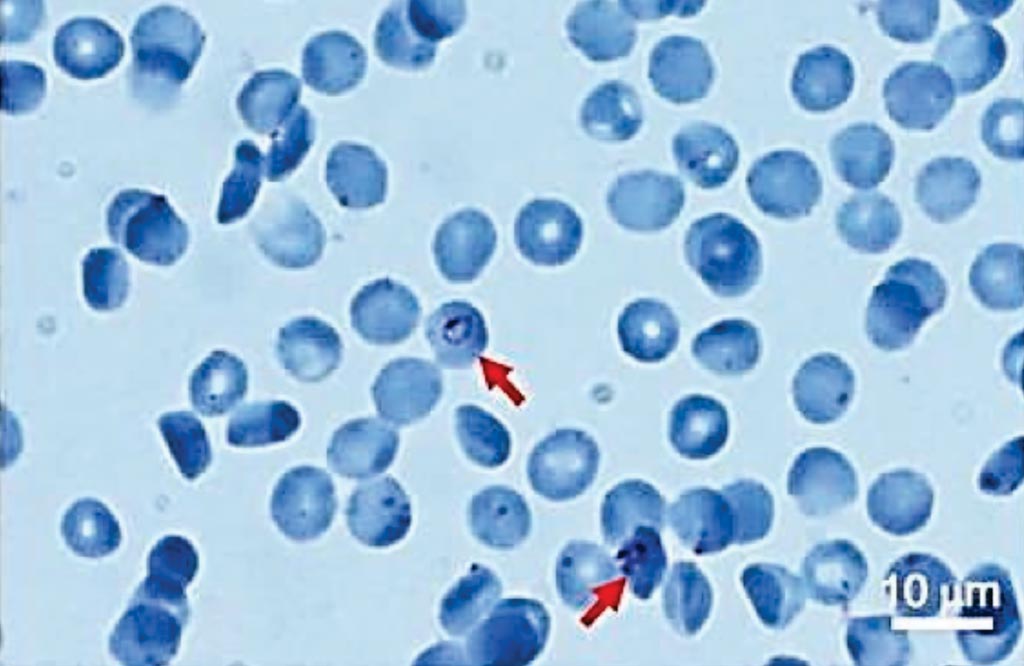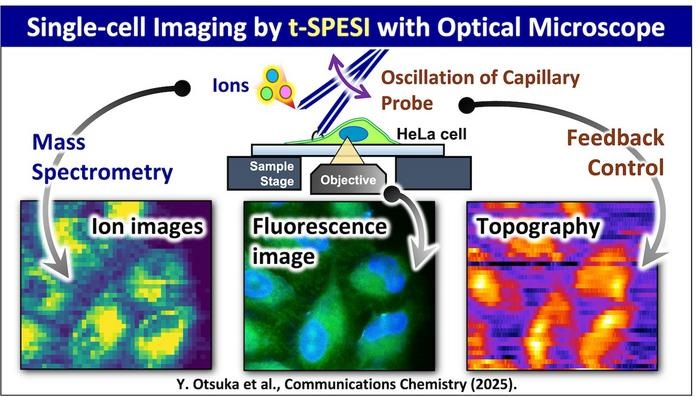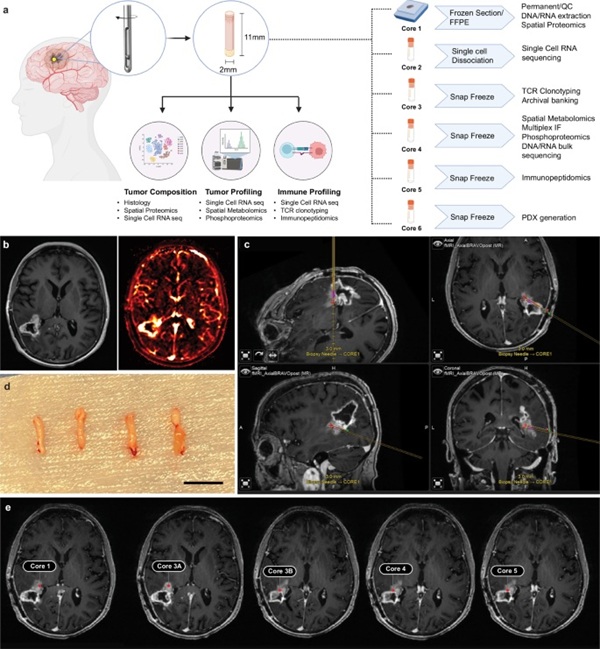Malaria Diagnosis Employs Hydrophilic-Treated Plastic Plates
|
By LabMedica International staff writers Posted on 30 Aug 2017 |

Image: A representative picture of Giemsa-stained hydrophilic-treated COC plates; Arrows indicate Plasmodium-infected cells (Photo courtesy of National Institute of Advanced Industrial Science and Technology).
Malaria is a red blood cell (RBC) infection caused by Plasmodium parasite and to determine RBC infection rate, which is essential for malaria study and diagnosis, microscopic evaluation of Giemsa-stained thin blood smears on glass slides is performed.
However, only a small area of the blood smear provides a monolayer of RBCs suitable for determination of infection rate, which is one of the major reasons for the low parasite detection rate by Giemsa microscopy. In addition, because Giemsa microscopy is exacting and time-consuming, automated counting of infection rates is highly desirable.
Scientists at the National Institute of Advanced Industrial Science and Technology (AIST, Tokyo, Japan) cultured a strain of P. falciparum for automated counting of infected parasites; the parasite-infected RBCs were stained with a cell-permeant green fluorescent nucleic acid stain. Bright field and fluorescence images of stained parasite-infected RBCs were acquired using a DM1L inverted fluorescence microscope.
The investigators developed a method that allows for microscopic examination of Giemsa-stained cells spread in a monolayer on almost the whole surface of hydrophilic-treated cyclic olefin copolymer (COC) plates. Because wide-range Giemsa microscopy can be performed on a hydrophilic-treated plate, the method may enable more reliable diagnosis of malaria in patients with low parasitemia burden. Furthermore, the number of RBCs and parasites stained with a fluorescent nuclear staining dye could be counted automatically with a software tool, without Giemsa staining. As a result, medical personnel studying malaria may calculate the infection rate easily, rapidly, and accurately even in low parasitemia.
The authors concluded that because the running cost of these methods is very low and they do not involve complicated techniques, and the use of hydrophilic COC plates may contribute to improved and more accurate diagnosis of malaria. The study was published on August 8, 2017, in the Malaria Journal.
Related Links:
National Institute of Advanced Industrial Science and Technology
However, only a small area of the blood smear provides a monolayer of RBCs suitable for determination of infection rate, which is one of the major reasons for the low parasite detection rate by Giemsa microscopy. In addition, because Giemsa microscopy is exacting and time-consuming, automated counting of infection rates is highly desirable.
Scientists at the National Institute of Advanced Industrial Science and Technology (AIST, Tokyo, Japan) cultured a strain of P. falciparum for automated counting of infected parasites; the parasite-infected RBCs were stained with a cell-permeant green fluorescent nucleic acid stain. Bright field and fluorescence images of stained parasite-infected RBCs were acquired using a DM1L inverted fluorescence microscope.
The investigators developed a method that allows for microscopic examination of Giemsa-stained cells spread in a monolayer on almost the whole surface of hydrophilic-treated cyclic olefin copolymer (COC) plates. Because wide-range Giemsa microscopy can be performed on a hydrophilic-treated plate, the method may enable more reliable diagnosis of malaria in patients with low parasitemia burden. Furthermore, the number of RBCs and parasites stained with a fluorescent nuclear staining dye could be counted automatically with a software tool, without Giemsa staining. As a result, medical personnel studying malaria may calculate the infection rate easily, rapidly, and accurately even in low parasitemia.
The authors concluded that because the running cost of these methods is very low and they do not involve complicated techniques, and the use of hydrophilic COC plates may contribute to improved and more accurate diagnosis of malaria. The study was published on August 8, 2017, in the Malaria Journal.
Related Links:
National Institute of Advanced Industrial Science and Technology
Latest Technology News
- Advanced Predictive Algorithms Identify Patients Having Undiagnosed Cancer
- Light Signature Algorithm to Enable Faster and More Precise Medical Diagnoses
- Disposable Microchip Technology Could Selectively Detect HIV in Whole Blood Samples
- Pain-On-A-Chip Microfluidic Device Determines Types of Chronic Pain from Blood Samples
- Innovative, Label-Free Ratiometric Fluorosensor Enables More Sensitive Viral RNA Detection
- Smartphones Could Diagnose Diseases Using Infrared Scans
- Novel Sensor Technology to Enable Early Diagnoses of Metabolic and Cardiovascular Disorders
- 3D Printing Breakthrough Enables Large Scale Development of Tiny Microfluidic Devices
- POC Paper-Based Sensor Platform to Transform Cardiac Diagnostics
- Study Explores Impact of POC Testing on Future of Diagnostics
- Low-Cost, Fast Response Sensor Enables Early and Accurate Detection of Lung Cancer
- Nanotechnology For Cervical Cancer Diagnosis Could Replace Invasive Pap Smears
- Lab-On-Chip Platform to Expedite Cancer Diagnoses
- Biosensing Platform Simultaneously Detects Vitamin C and SARS-CoV-2
- New Lens Method Analyzes Tears for Early Disease Detection
- FET-Based Sensors Pave Way for Portable Diagnostic Devices Capable of Detecting Multiple Diseases
Channels
Clinical Chemistry
view channel
AI-Powered Blood Test Accurately Detects Ovarian Cancer
Ovarian cancer ranks as the fifth leading cause of cancer-related deaths in women, largely due to late-stage diagnoses. Although over 90% of women exhibit symptoms in Stage I, only 20% are diagnosed in... Read more
Automated Decentralized cfDNA NGS Assay Identifies Alterations in Advanced Solid Tumors
Current circulating cell-free DNA (cfDNA) assays are typically centralized, requiring specialized handling and transportation of samples. Introducing a flexible, decentralized sequencing system at the... Read more
Mass Spectrometry Detects Bacteria Without Time-Consuming Isolation and Multiplication
Speed and accuracy are essential when diagnosing diseases. Traditionally, diagnosing bacterial infections involves the labor-intensive process of isolating pathogens and cultivating bacterial cultures,... Read more
First Comprehensive Syphilis Test to Definitively Diagnose Active Infection In 10 Minutes
In the United States, syphilis cases have surged by nearly 80% from 2018 to 2023, with 209,253 cases recorded in the most recent year of data. Syphilis, which can be transmitted sexually or from mother... Read moreMolecular Diagnostics
view channel
POC Diagnostic Platform Combines Immunoassay and Molecular Testing
An innovative diagnostic platform offers superior sensitivity across all sample types, including blood, compared to existing rapid tests, while maintaining a low-cost, user-friendly design.... Read more
Single Blood Test Could Detect Different Types of Cancer at Early Stages
Currently, reliable screening for only a few types of cancer is available, such as those affecting the breast, bowel, cervix (neck of the womb), and lung for individuals at high risk. While these screenings... Read moreHematology
view channel
First Point-of-Care Heparin Monitoring Test Provides Results in Under 15 Minutes
Heparin dosing requires careful management to avoid both bleeding and clotting complications. In high-risk situations like extracorporeal membrane oxygenation (ECMO), mortality rates can reach about 50%,... Read more
New Scoring System Predicts Risk of Developing Cancer from Common Blood Disorder
Clonal cytopenia of undetermined significance (CCUS) is a blood disorder commonly found in older adults, characterized by mutations in blood cells and a low blood count, but without any obvious cause or... Read moreImmunology
view channel
Stem Cell Test Predicts Treatment Outcome for Patients with Platinum-Resistant Ovarian Cancer
Epithelial ovarian cancer frequently responds to chemotherapy initially, but eventually, the tumor develops resistance to the therapy, leading to regrowth. This resistance is partially due to the activation... Read more
Machine Learning-Enabled Blood Test Predicts Immunotherapy Response in Lymphoma Patients
Chimeric antigen receptor (CAR) T-cell therapy has emerged as one of the most promising recent developments in the treatment of blood cancers. However, over half of non-Hodgkin lymphoma (NHL) patients... Read moreMicrobiology
view channel
New Blood Test Detects Up to Five Infectious Diseases at POC
Researchers have developed a prototype flow-through assay capable of detecting up to five different infections, with results that can be quickly analyzed and transmitted via a specialized smartphone app.... Read more
Molecular Stool Test Shows Potential for Diagnosing TB in Adults with HIV
Tuberculosis (TB), caused by the bacterium Mycobacterium tuberculosis, led to 1.25 million deaths in 2023, with 13% of those occurring in people living with HIV. The current primary diagnostic method for... Read morePathology
view channel
New Technology Improves Understanding of Complex Biological Samples
Tissues are composed of a complex mixture of various cell types, which complicates our understanding of their biological roles and the study of diseases. Now, a multi-institutional team of researchers... Read more
Combining Multiple Laboratory Techniques Provides Deeper Insights into Deadly Brain Tumors
Glioblastoma (GBM) is a highly aggressive primary brain cancer that currently has limited effective treatments. Stereotactic needle biopsies are commonly employed for diagnosis; however, their use is restricted... Read more
AI-Based Diagnosis System Identifies Malaria Parasites from Blood Smear Images
Malaria diagnosis has traditionally been performed manually via microscopic examination, a process that is not only time-consuming but also highly dependent on the expertise and accuracy of healthcare providers.... Read moreIndustry
view channel
Qiagen Acquires NGS Analysis Software Company Genoox
QIAGEN (Venlo, the Netherlands) has signed a definitive agreement to acquire Genoox (Tel Aviv, Israel), a provider of artificial intelligence (AI)-powered software that enables clinical labs to scale and... Read more
Cepheid and Oxford Nanopore Technologies Partner on Advancing Automated Sequencing-Based Solutions
Cepheid (Sunnyvale, CA, USA), a leading molecular diagnostics company, and Oxford Nanopore Technologies (Oxford, UK), the company behind a new generation of sequencing-based molecular analysis technologies,... Read more
Grifols and Tecan’s IBL Collaborate on Advanced Biomarker Panels
Grifols (Barcelona, Spain), one of the world’s leading producers of plasma-derived medicines and innovative diagnostic solutions, is expanding its offer in clinical diagnostics through a strategic partnership... Read more









 RapiCardTM InstaTest (Serum-WB-Plasma).jpg)









